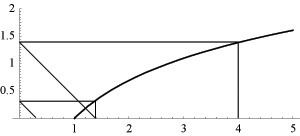 | ||
In computer science, the iterated logarithm of n, written log* n (usually read "log star"), is the number of times the logarithm function must be iteratively applied before the result is less than or equal to 1. The simplest formal definition is the result of this recursive function:
Contents
On the positive real numbers, the continuous super-logarithm (inverse tetration) is essentially equivalent:
but on the negative real numbers, log-star is 0, whereas
In computer science, lg* is often used to indicate the binary iterated logarithm, which iterates the binary logarithm instead. The iterated logarithm accepts any positive real number and yields an integer. Graphically, it can be understood as the number of "zig-zags" needed in Figure 1 to reach the interval [0, 1] on the x-axis.
Mathematically, the iterated logarithm is well-defined not only for base 2 and base e, but for any base greater than
Analysis of algorithms
The iterated logarithm is useful in analysis of algorithms and computational complexity, appearing in the time and space complexity bounds of some algorithms such as:
The iterated logarithm grows at an extremely slow rate, much slower than the logarithm itself. For all values of n relevant to counting the running times of algorithms implemented in practice (i.e., n ≤ 265536, which is far more than the estimated number of atoms in the known universe), the iterated logarithm with base 2 has a value no more than 5.
Higher bases give smaller iterated logarithms. Indeed, the only function commonly used in complexity theory that grows more slowly is the inverse Ackermann function.
Other applications
The iterated logarithm is closely related to the generalized logarithm function used in symmetric level-index arithmetic. It is also proportional to the additive persistence of a number, the number of times someone must replace the number by the sum of its digits before reaching its digital root.
Santhanam shows that DTIME and NTIME are distinct up to
